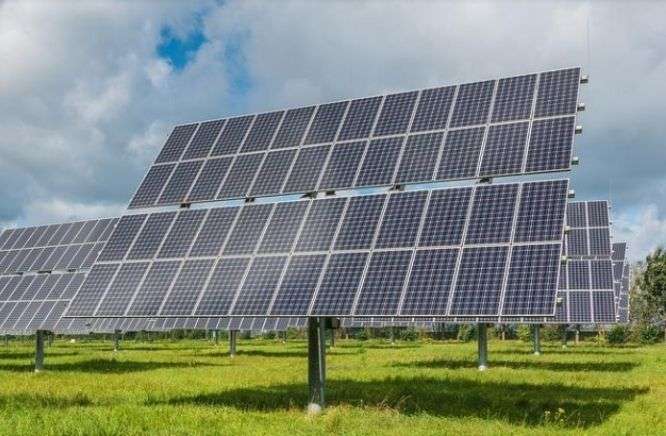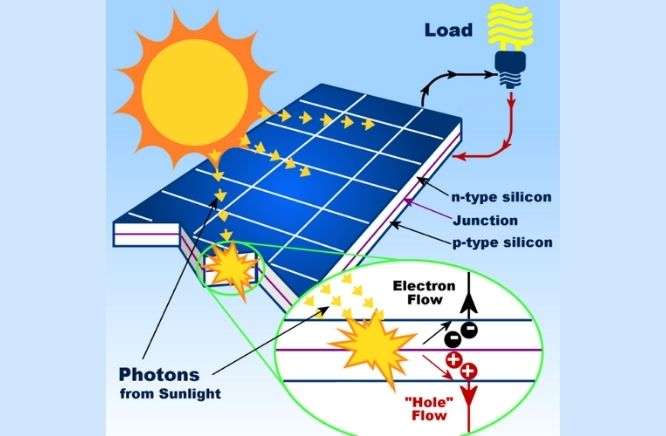
Our sun is a natural nuclear reactor that releases tiny packets of energy called photons.
These photons travel 93 million miles from the sun to earth in 8 minutes and 20 seconds.
The earth receives a very less fraction of solar power released by the sun.
Even though it’s such a small amount, the Earth intercepts a lot of solar power.
That energy is 173 petawatts (1.73 * 10^17 w), i.e. ten thousand times more power than the planet’s population uses.
If we could utilize a single hour of sunlight received by the earth, it would be enough to generate solar energy for our planet to satisfy global needs for a whole year.
How does a solar panel work?
Solar panels keep generating electricity for us from the crown rooftop and streetlight provides light at night and it even helps to power spacecraft.
But, what’s the actual science behind the working of solar panels?
For a solar panel to generate electricity, the photons should knock electrons free from atoms, according to the University of Minnesota Duluth.
A solar panel consists of smaller units called photovoltaic cells; it converts solar energy into electrical energy. When these cells are connected to each other, they form a solar panel.
We all know that solar panels convert solar energy into electrical energy but few people know the actual science behind the process.
After reading this article, you will know about the working of solar panel easily.
What is the Photovoltaic (PV) Effect?
Basically, the photovoltaic effect means the process of conversion of sunlight into electricity.
This effect is the ability of the potential of matter to release electrons when bathed in light.
Photovoltaic Cells
Photovoltaic cells are made of semi-conductive materials, most often silicon; the second most abundant element on earth after aluminum.
Silicon is the essential component for photovoltaic cells.
These materials can transmit electricity while maintaining the electrical imbalance needed to create an electric field.
PV cells absorb solar energy during the day and create electrical charges that move in response to an internal electric field in the cell, causing electricity to flow.
2 Solar Technologies
1. Photovoltaic (PV) Panels: They produce electricity by the process of the photovoltaic effect.
2. Concentrated Solar Panel (CSP): They concentrate solar radiation of a large area through a mirror or lenses onto a receiver.
How do solar cells generate electricity?
When photons of sunlight hit a solar cell, it creates electrical charges that move in response to the internal electric field in the cell, causing electricity to flow through it.
99.999% pure silicon is used as a semiconductor in solar cells where there are no free charge carriers.
Well, 2 doping is done in pure silicon with aluminum and boron to allow the floating of electrons in a unidirectional way and thus create electricity.
In 1st doping “P-type doping”, we have to add aluminum to the silicon. It forms N-type semiconductors, where it can now gain electrons.
In the 2nd doping “N-type doping”, we have to add boron to the silicon. It forms P-type semiconductors, where it can now lose electrons.

When combining P-type and N-type semiconductors, some electrons from N-type semiconductors will move to P-type semiconductors.
This creates a depletion region or a junction where no electrons could pass through it.
When the light strikes the N junction of the PV cell, it penetrates and reaches up to the depletion region.
This photon energy is sufficient to generate electron-hole pairs in the depletion region.
The electric field in the depletion region drives the electrons and holes out of the depletion region.
Here we observe that the concentration of electrons in the N region and holes in the P region become so high that a potential difference will develop between them.
So, this will create an internal electric field where the N side will be negatively charged and the p side will be positively charged.
When we connect any device between those regions, electrons will start flowing through the devices.
The electrons will recombine with the holes in the P region after completing their path.
In this way, a solar cell continuously gives direct current.
Advantages of solar energy
The main advantages of solar energy are as follows:
1. pollution-free
2. reduce electricity bills number
3. promotes renewable sources of energy
4. causes no emission of greenhouse gasses
5. no noise pollution due to no moving parts
6. solar power is economic in the long run
7. suitable for remote Areas where electric grades are not available
8. It also provides net metering to homeowners for their Electricity production and returning to the grid. The surplus electricity is either sent to the grid or stored in the batteries.
History of Solar Panel
The development of solar energy goes back more than 100 years (more than a century).
In the early days, people used solar energy for steam production to run machinery.
Later in 1839, Physicist Edmond Becquerel discovered the photovoltaic effect while experimenting with a cell made of metal electrodes in a conducting solution; it allowed the conversion of sunlight into electrical energy.
After Becquerel’s discovery, in 1893, Charles Fritts developed the first genuine solar cell by coating selenium sheets with a thin layer of gold.
These scientists’ contribution arises from the device we know today as the solar panel.
In 1941, Russel Ohl, an American inventor on the payroll at Bell Laboratories patented the world’s first silicon solar cell (modern solar cell). Later, the same company produced the first solar panel in 1954.
Space satellites started using solar panels normally and in most people’s lives, they saw the first solar panel installed on their new calculator – Circa the 1970s!
Today, solar panel systems are powering a wide variety of applications from installing solar panels in roof-top of entire homes to commercial buildings, such as Google’s headquarters in California.





![7 Steps To Install Ring Solar Panel? [STEP-BY-STEP] Ring Solar Panel](https://spaceupper.com/wp-content/uploads/2022/10/Ring-Solar-Panel-300x186.jpg)





